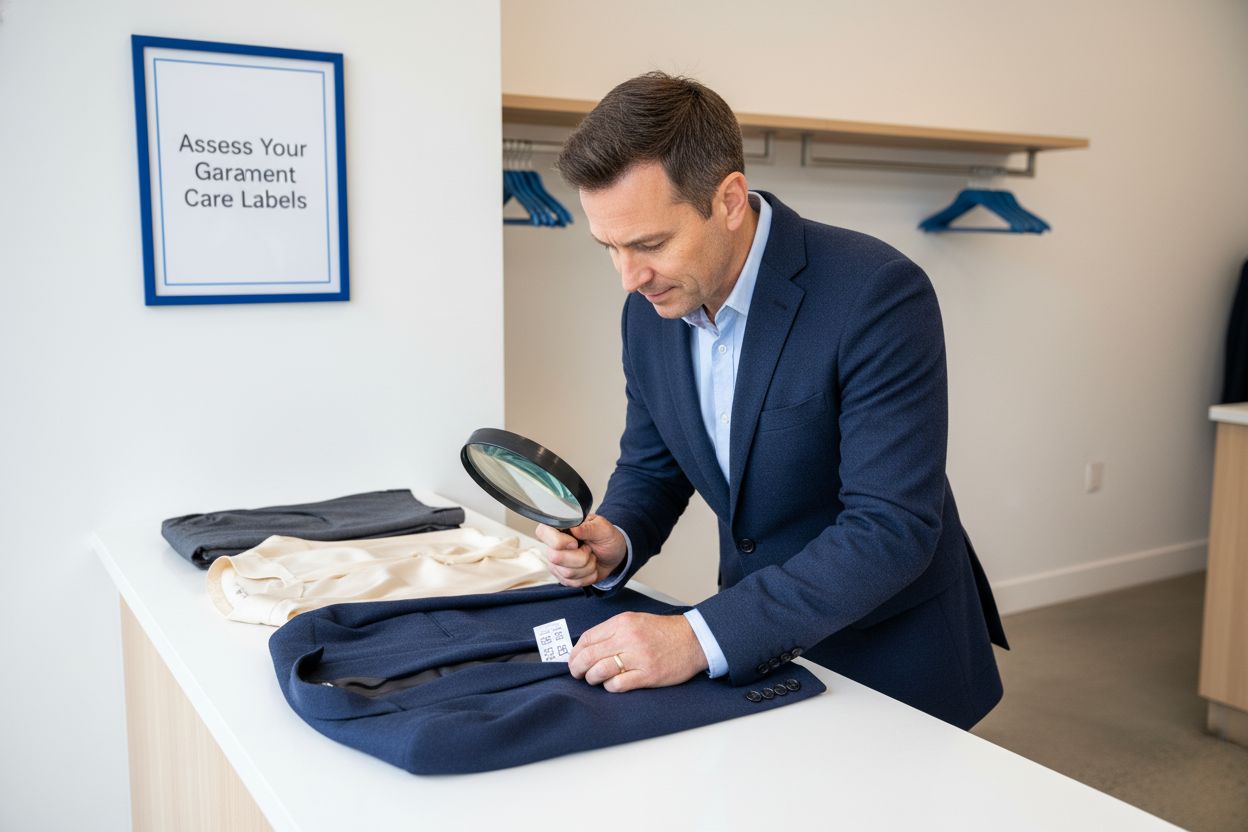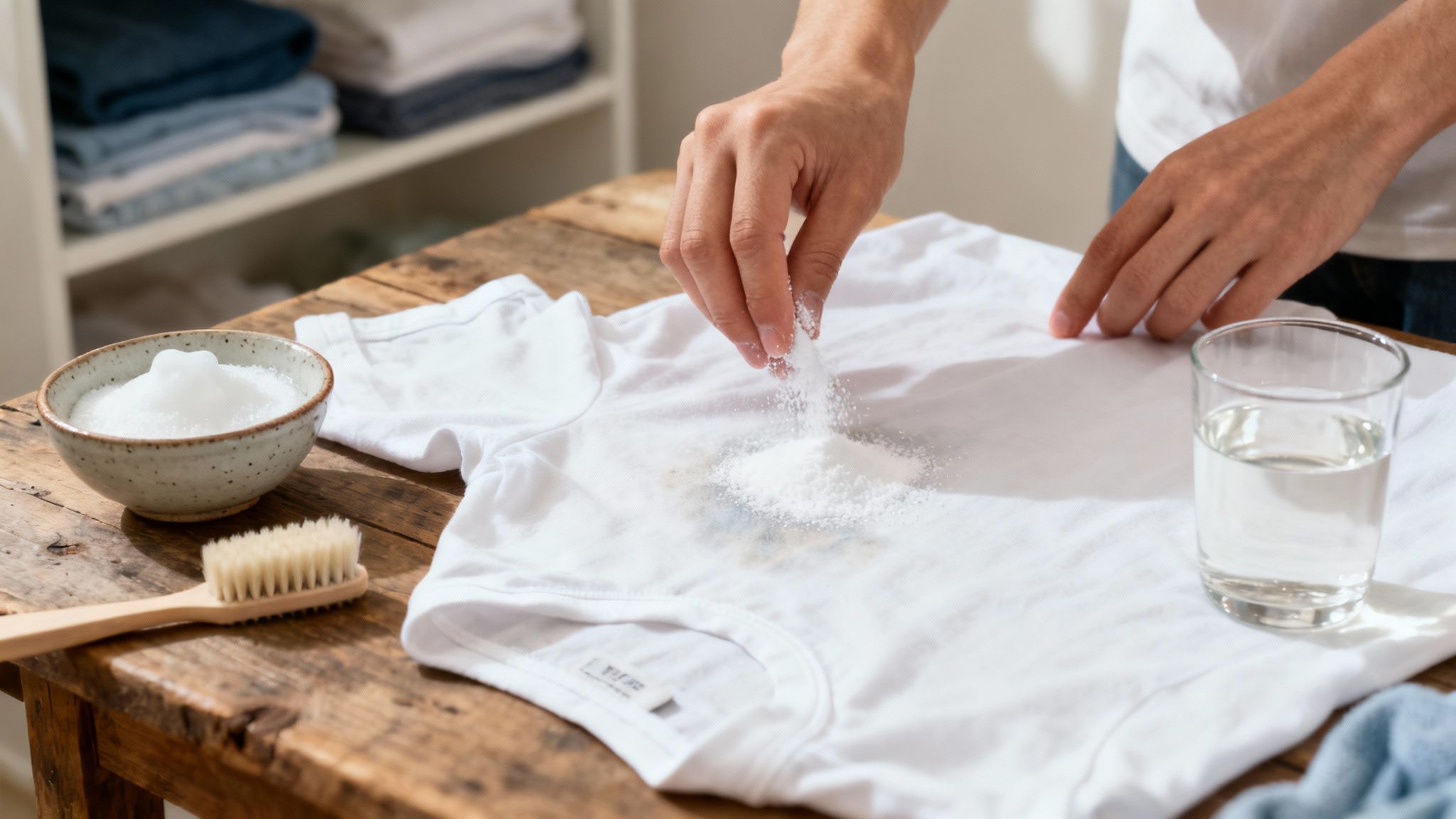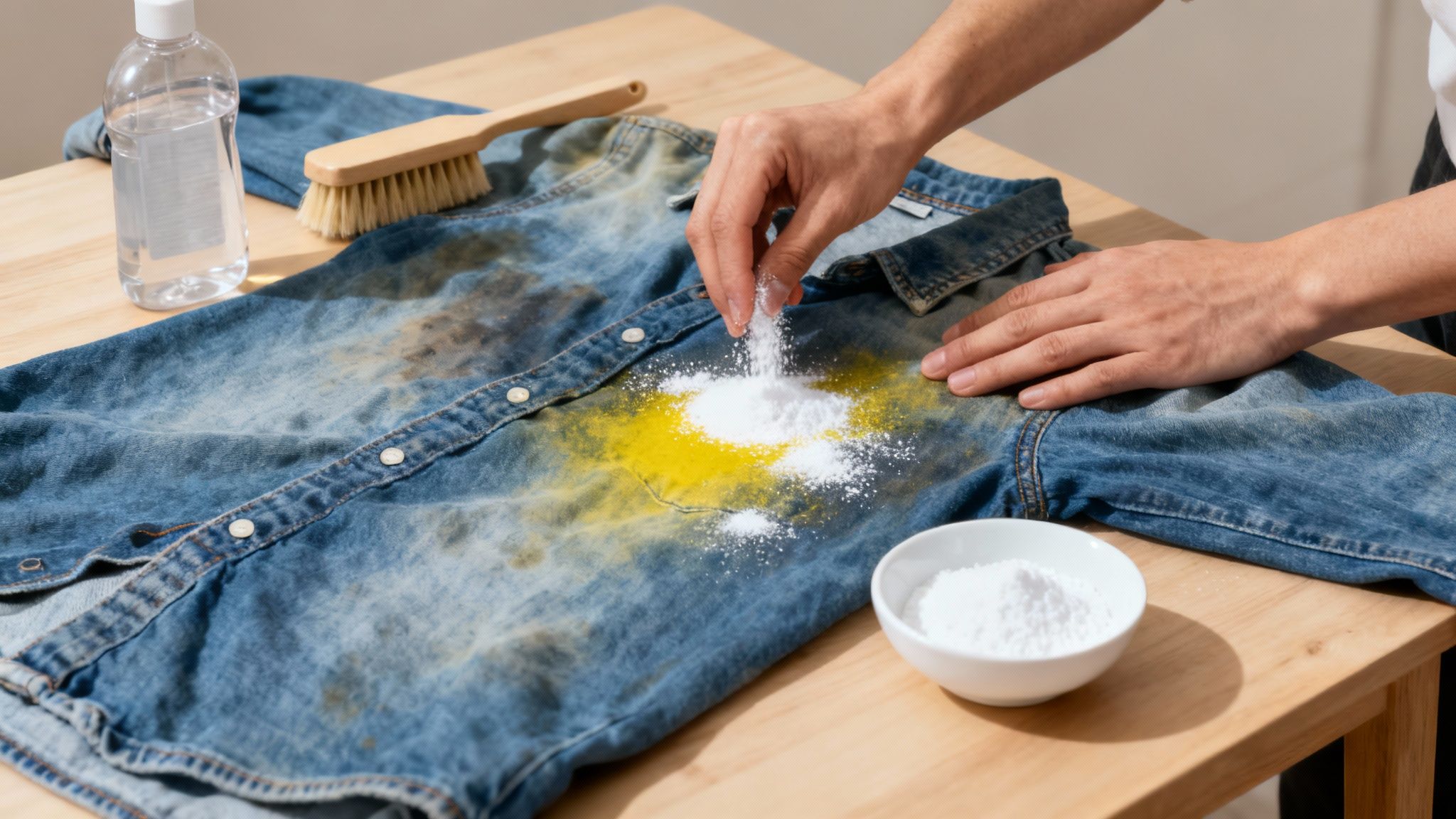How to Remove Chocolate Stains From Clothing: 5 Simple Tips
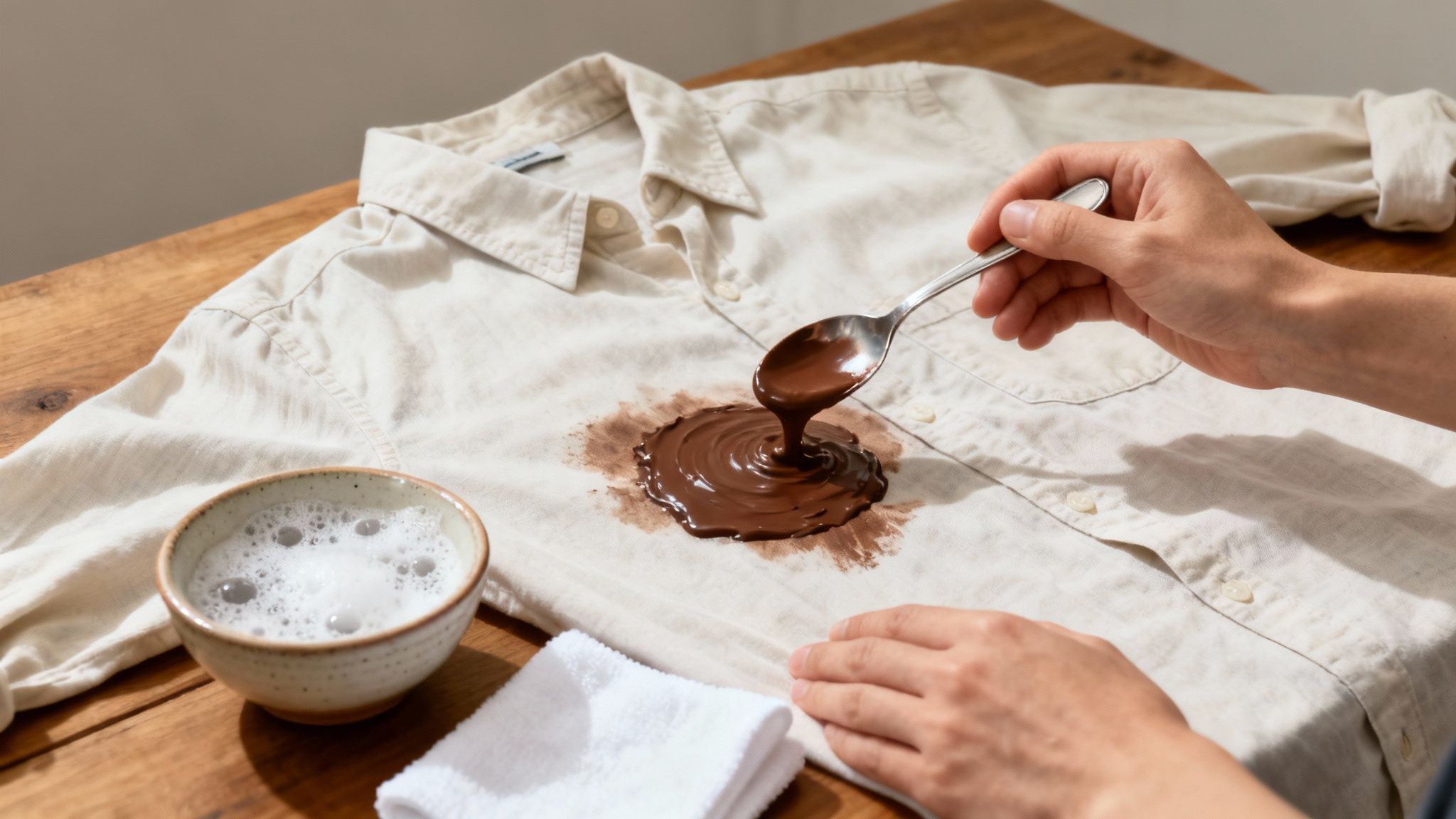
We’ve all been there: that sinking feeling when a rogue piece of chocolate lands squarely on your favorite shirt. Before you do anything else, just take a breath. What you do in these first few minutes is what really determines if that stain becomes a permanent resident or a distant memory.
Your First Five Minutes Can Save Your Garment
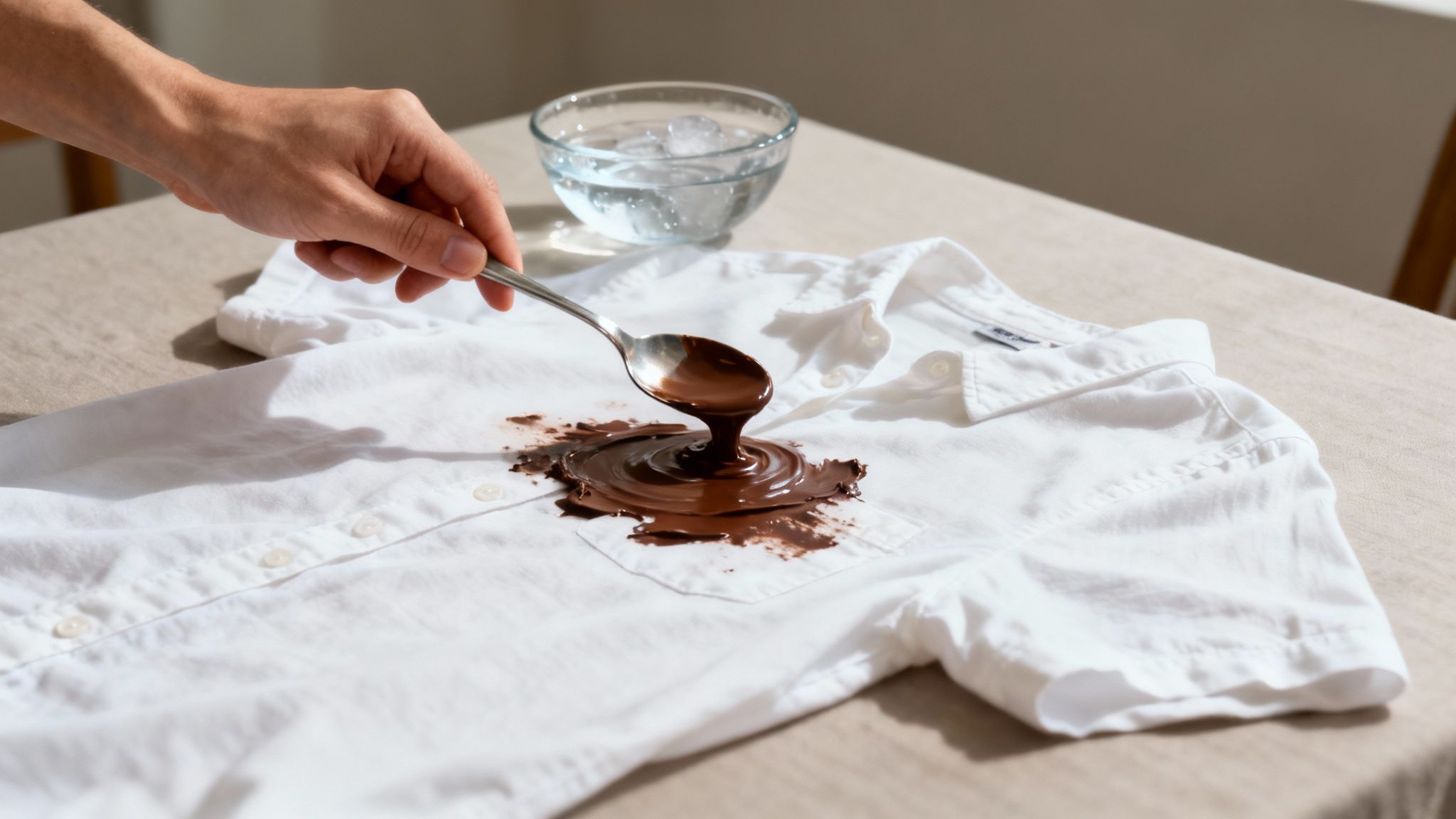
The clock is ticking, but don't panic. Acting fast—and smart—is the key to success.
Act Quickly and Carefully
First things first: get rid of any solid chunks of chocolate immediately. Whatever you do, resist the urge to grab a napkin and wipe it. That’s the biggest mistake you can make, as it just grinds the oils and sugars deeper into the fabric, making your job ten times harder.
Instead, reach for something with a dull edge, like a butter knife or the side of a spoon. Gently lift or scrape away the excess chocolate. The idea is to remove as much as you can from the surface without applying any pressure. This one simple move stops the bulk of the stain from ever setting in.
Use Cold Water, Not Hot
With the solids gone, you might be tempted to blast the stain with hot water. Stop right there. This is a critical error in the world of stain removal.
You need to rinse the spot with cold water, and just as importantly, do it from the back of the fabric. Why? Hot water will essentially "cook" the proteins in the chocolate, setting the stain permanently. It’s a laundry nightmare. You can learn more about the science behind this from the pros at Rinse.com.
By running cold water through the back, you’re pushing the chocolate particles out of the fibers the same way they went in, rather than forcing them deeper into the material. It's a small detail that makes a huge difference.
Treating Fresh Chocolate Stains with Household Items
So, you’ve scraped away the solid bits and rinsed the stain with cold water. Good start. Now it's time to actually treat the stain, and you probably don't need to run out and buy a special product. Your best weapon is likely already sitting in your laundry room.
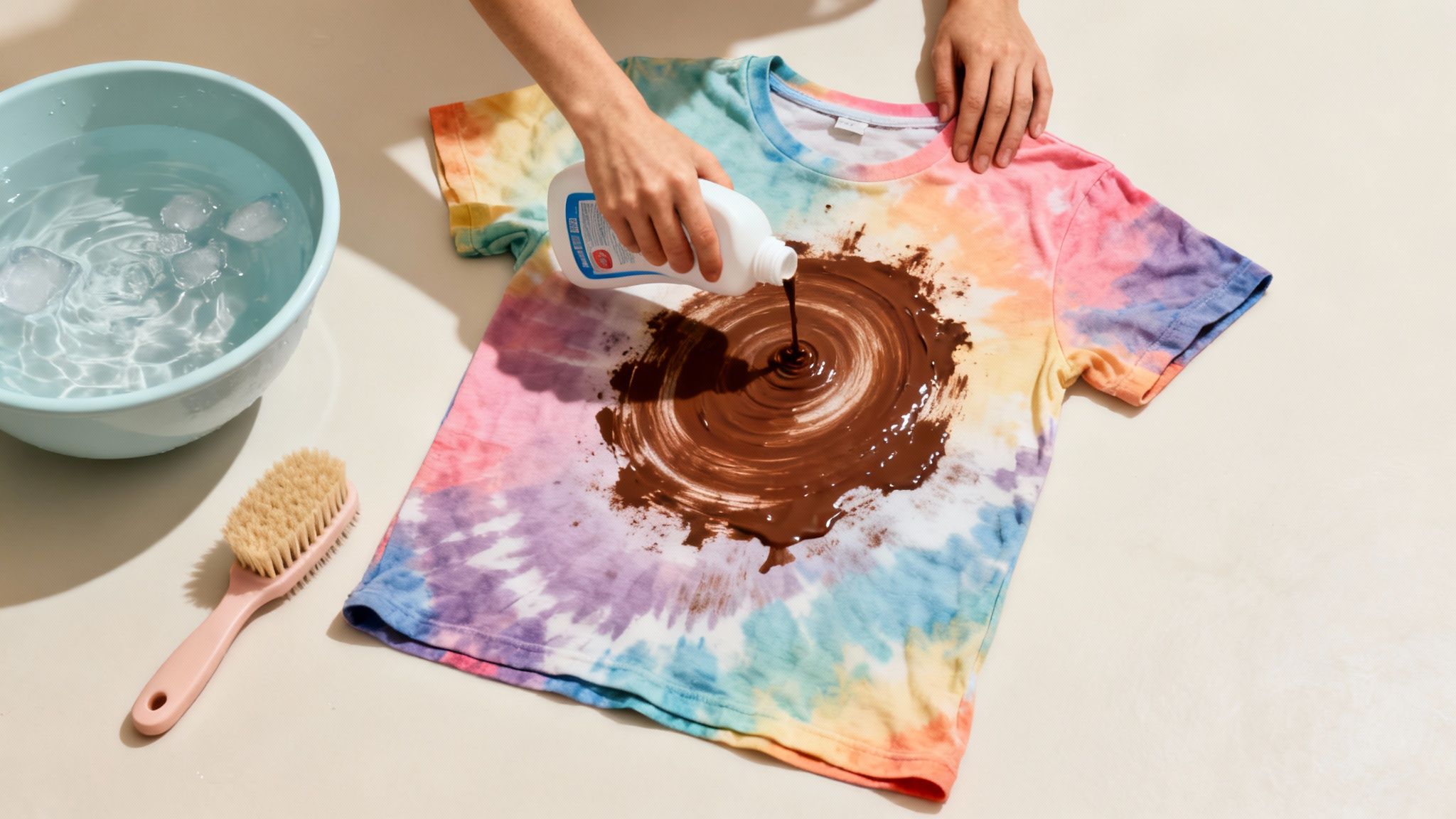
Honestly, your everyday liquid laundry detergent is usually the most effective tool for the job. The enzymes packed into modern detergents are brilliant at breaking down the fats and proteins that make chocolate such a pain to get out.
Applying Your Chosen Cleaner
Grab your liquid detergent and pour a small amount right onto the dampened stain. You just need enough to cover the chocolatey mess completely. If you’re fresh out of liquid detergent, a good grease-cutting dish soap can work in a pinch, since it’s designed to tackle oily stuff.
Next, gently work the cleaner into the fabric. You can use your fingers or a soft-bristled toothbrush for this. I find a circular motion, starting from the outside of the stain and working inward, is best. This helps stop the stain from spreading and really pushes the detergent deep into the fibers where those chocolate particles are hiding.
Now, walk away. Let the cleaner sit on the fabric for at least five to ten minutes. This is where the magic happens—it gives the enzymes time to do their job and start digesting the stain. For a really stubborn spot, you can even let it sit for up to 30 minutes.
I can't stress this enough: be patient. Rushing this step is the most common mistake I see, and it almost always leads to a faint stain remaining after the wash. Let the detergent work!
Using Other Common Household Items
You’ve got a surprising number of stain-fighting options right in your kitchen. If you're looking for broader ideas on using household staples, some guides on how to clean carpet stains with vinegar offer great insights that can apply to more than just floors.
To help you decide what to grab, here’s a quick rundown of a few common household helpers.
Quick Comparison of Common Stain Treatments
Each of these has its place, but for a classic chocolate stain, detergent is usually my go-to.
Once your chosen treatment has had time to sit, it’s time for a final rinse before the machine. I like to submerge the stained area in a bowl of cold water and swish it around. You'll actually see the stain start to lift as the water gets murky.
After a thorough rinse, toss it in the washing machine. And remember the golden rule: check that the stain is 100% gone before you even think about putting it in the dryer. Heat will set that stain for good.
How to Tackle Old and Set-In Chocolate Stains
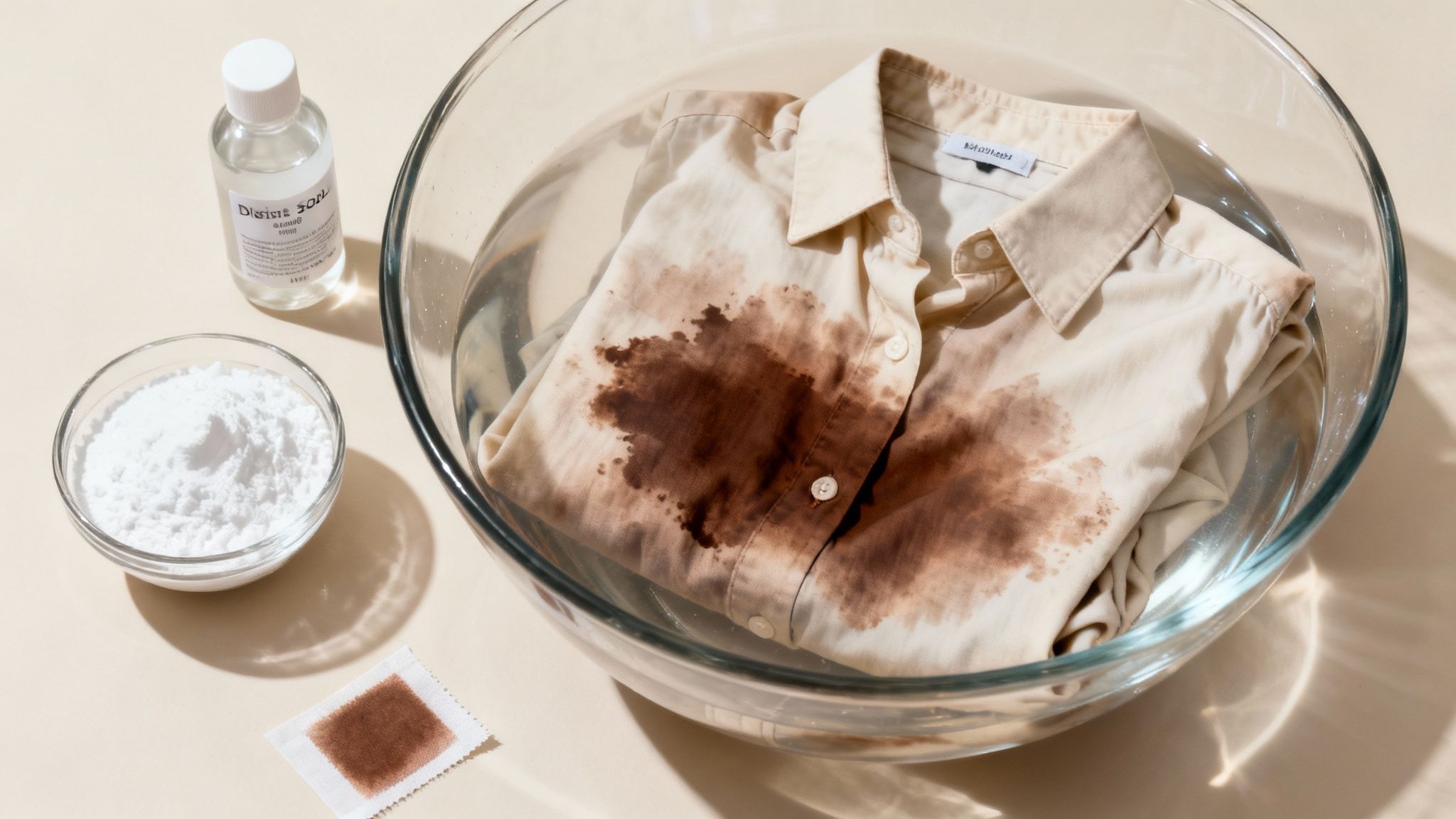
Finding a dried, crusty chocolate stain that’s been there for days can feel like a lost cause. At this point, the fats and sugars have had plenty of time to work their way deep into the fabric fibers, making them much tougher to deal with than a fresh spill.
But don’t give up on that shirt just yet. With a slightly more intensive approach, you can still bring it back from the brink.
A simple pre-treatment spot just won’t cut it for these old stains. You need to give your cleaning solution some serious time to work its magic. This is where a good, long pre-soak becomes your secret weapon. Soaking the garment allows the cleaning agents to fully penetrate those set-in stains and start breaking them down.
Creating a Powerful Pre-Soak Solution
For a stubborn, set-in chocolate stain, an enzyme-based laundry detergent is your best bet. Why? Enzymes are specifically designed to dismantle the complex protein and fat molecules that make chocolate stains so tricky.
Here’s how to get your soak started:
- First, fill a basin or sink with cool water. And I mean cool—hot water is the enemy here and can set the stain permanently, even during a soak.
- Add a capful of a quality liquid enzyme detergent and give the water a good swish to make sure it dissolves completely.
- Submerge the stained item, making sure the chocolatey area is completely underwater.
You’ll want to let the item soak for at least 30 minutes. But for those really old, stubborn stains, leaving it overnight can make all the difference. Honestly, patience is your best friend here. Every hour it soaks gives those enzymes more time to do their job.
Pro Tip: Before you commit to a long soak, always do a quick spot test. Dab a little of your cleaning solution on a hidden part of the garment, like an inside seam, just to make sure it won’t cause any color fading or fabric damage.
If the stain is particularly nasty or on a delicate fabric, sometimes a professional touch is the smartest move. It can be helpful to understand how dry cleaners remove stains to know when it's time to call in the experts.
After soaking, gently rub the stained area between your fingers to loosen any remaining particles, then launder as you normally would. Just be sure to air-dry it first to make absolutely certain the stain is gone for good.
Choosing the Right Stain Remover for Chocolate
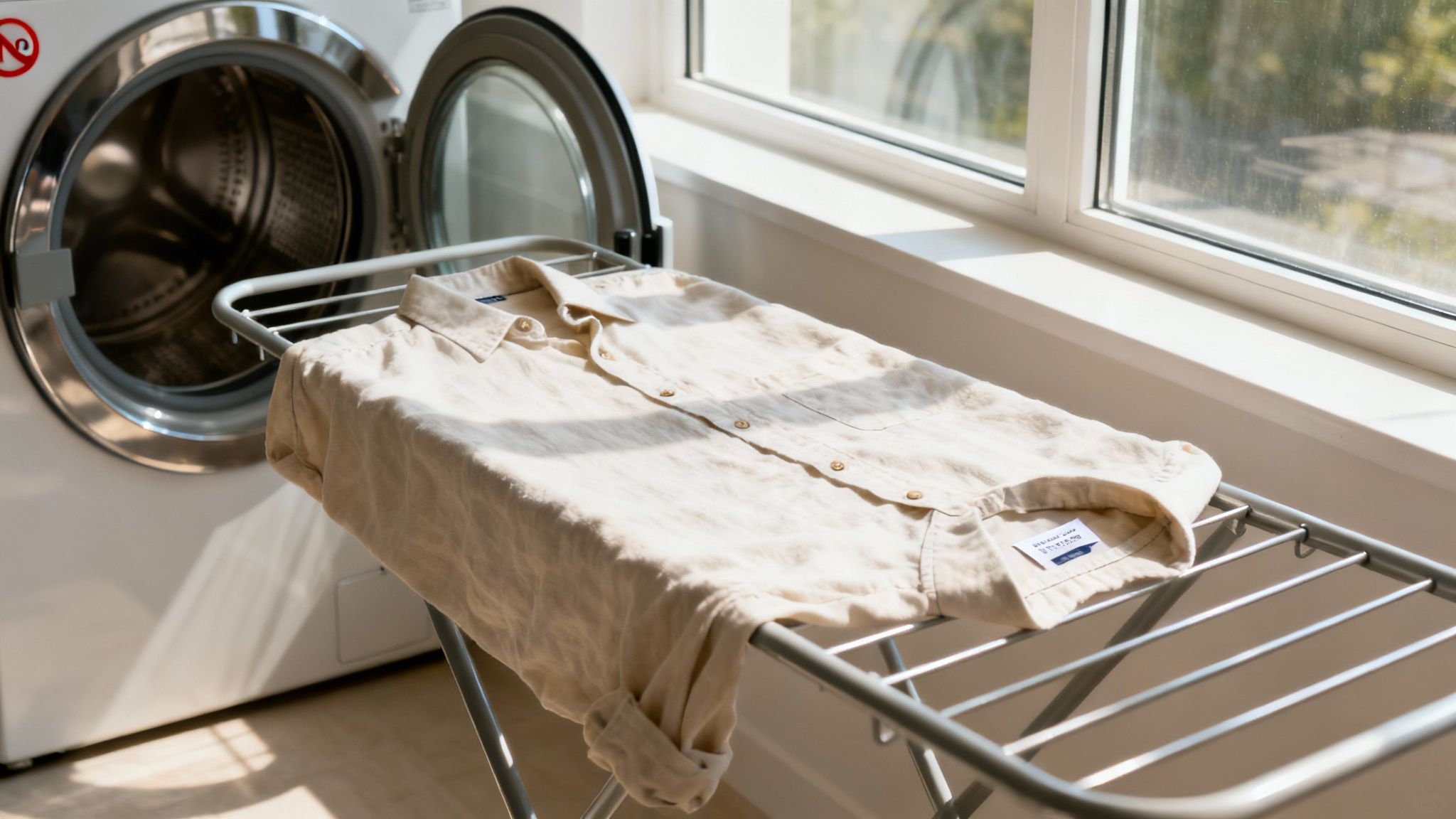
Walking down the laundry aisle can feel a little overwhelming, right? But grabbing the right product can turn a potential laundry disaster into a simple fix. When you're dealing with a chocolate stain, knowing what's in the bottle is your secret weapon.
Chocolate is a tricky one because it’s a combination stain—it has both fats (from the cocoa butter) and proteins. That’s why your standard all-purpose cleaner might not cut it. The global stain remover market is worth around USD 25 billion for a reason; people need powerful, specific solutions for messes like this.
Understanding Your Options
When you’re staring at that wall of products, you’ll mostly see a few different types of removers. Each one works a bit differently, so knowing which to reach for is key.
- Enzyme-Based Cleaners: These are your MVP for chocolate stains. They’re packed with enzymes specifically designed to break down the proteins and fats that make up the stain. Think of them as tiny stain-fighting machines.
- Oxygen Bleaches: Anything with "Oxi" in the name falls into this category. They're a fantastic, color-safe alternative to chlorine bleach and give you an extra boost against stubborn, set-in stains, especially on whites.
- Solvent-Based Spot Treatments: These are the heavy hitters, made to dissolve greasy and oily messes. They work well, but they can be a bit harsh on delicate fabrics like silk or wool. My advice? Always do a spot test on a hidden seam first.
For a classic chocolate-on-a-t-shirt situation (we’ve all been there), an enzyme-based detergent is hands-down the best place to start. It goes right after the core components of the stain, doing most of the hard work before the wash cycle even begins.
If you prefer to go the gentle route, it’s worth checking out some of the best non-toxic cleaning products out there.
Ultimately, the more you understand how different removers work, the less you'll have to guess. We've actually put together a whole guide on how different removers tackle specific stains if you want to dive deeper.
The Final Wash: Don't Let The Dryer Ruin Your Hard Work
You've done the tough part and pre-treated that stubborn chocolate stain. Now it's time for the final wash, but don't get complacent. This last step is just as important as the first one, and a simple mistake here can set you right back to square one.
Before you toss the garment in, take a quick peek at the fabric care label. This little tag is your best friend, telling you exactly what the fabric can handle. You'll want to use the warmest water setting that's safe for your garment. A little heat helps break down any leftover oily residue from the chocolate.
The Golden Rule of Stain Removal
Once the wash cycle finishes, your first thought is probably to throw the item straight into the dryer. Stop right there. This is the single most critical rule when you're fighting any stain, especially chocolate.
The intense heat of a dryer will cook any remaining stain right into the fabric fibers, setting it for good. Trust me, once that happens, it's almost impossible to get it out.
Critical Takeaway: The dryer is your enemy until you are 100% certain the stain is gone. Never, ever put a potentially stained piece of clothing in there.
Instead, let the garment air-dry. Hang it on a rack, lay it flat, whatever works for you. If you need some pointers on drying clothes inside without turning your room into a damp cave, check out our guide on how to air-dry clothes indoors.
After it's completely dry, give the spot a thorough inspection in good, bright light. If you can still see a ghost of the stain, no worries. Just repeat the pre-treatment steps and wash it again. A little patience now saves you from a permanently stained shirt later.
Still Have Questions About Chocolate Stains?
Even when you follow the steps, some situations just make you pause. Let's tackle some of the most common questions that come up when you're face-to-face with a chocolate disaster.
Can I Use Dish Soap on a Chocolate Stain?
In a pinch, yes! A good grease-cutting dish soap can definitely step in as a substitute. Just dab a small amount right onto the stain, work it in gently, and give it about five minutes to sit before rinsing it all out with cold water.
That said, an enzyme-based laundry detergent is almost always going to be your best bet. It’s specifically designed to break down both the fats and the proteins in chocolate, giving it a powerful one-two punch that dish soap just can't match.
How Do I Treat Chocolate Stains on Silk or Wool?
When you're dealing with delicate fabrics like silk or wool, the key is to be incredibly gentle. After you've scraped off any solid bits of chocolate, carefully blot the stain with a clean cloth dipped in cool water and a super mild, pH-neutral detergent (think Woolite or something similar).
Always work from the outside edge of the stain inward. This little trick helps keep the stain from spreading and becoming an even bigger problem.
A Word of Caution: Steer clear of enzyme cleaners on these natural protein fibers. Over time, those enzymes can actually damage the fabric. If it's a piece you truly love, your safest bet is always to trust it to a professional dry cleaner.
What If the Stain Is Still There After Washing?
Whatever you do, do not put the garment in the dryer. That heat is your enemy—it will set whatever is left of the stain for good, making it a permanent part of the fabric.
Instead, tackle that damp spot again. Re-treat it with your stain remover or a bit of liquid detergent, and let it sit for at least 30 minutes. For really stubborn spots, you might even need to soak the item overnight in cold water before giving it another wash. Sometimes it takes two or three rounds in the ring to finally knock a tough stain out.
Tired of battling stains and endless laundry piles? Let Columbia Pike Laundry give you your time back. We offer professional wash & fold and dry cleaning services with convenient pickup and delivery. Schedule your first pickup today and rediscover your weekend.
Popular Blog Articles

Meet the Author
Daniel Logan didn’t start CPL because he loved laundry. He started it because his family was drowning in time debt, and laundry was one of the biggest weights.
Mornings were chaos with two kids under 5. Evenings felt like catch-up. And weekends? Gone to sorting socks and folding piles.
He knew his story wasn’t unique. So he built a business that gave families like his just a little bit of breathing room one load at a time.
With no laundry experience but deep tech skills, Daniel rolled up his sleeves, doing every job himself while building systems that turned it into a modern laundry service that saves customers time, simplifies their lives, and delivers reliability they can count on.
That’s where CPL began. Not from a playbook, but from pain. From one dad trying to buy back time: for himself, and for every household like his.



